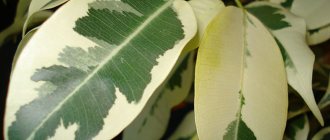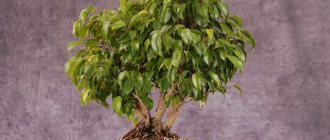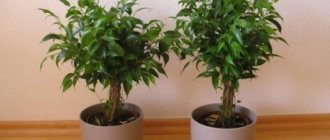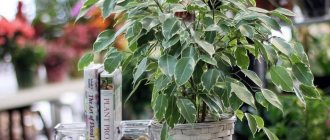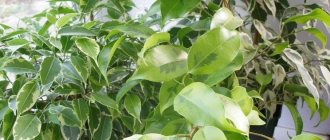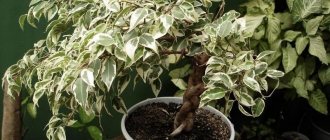The variegated ficus is an evergreen tree, shrub or flower (it can even be called that). Today there are more than 1000 varieties of this ficus all over the world, which grow in almost every corner of the globe. Despite this, Southeast Asia is considered the birthplace of ficus trees. The mulberry family shrub can be single-colored or variegated.
Many gardeners fell in love with variegated species for their bright colors and some originality. Of course, it is difficult to argue that Ficus benjamina, with its “fleshy” and large leaves, is a less attractive or beautiful plant, but sometimes you want some variety.
When purchasing ficus trees, you must remember that they require special care. As for the variegated specimens, they are not as capricious as some others, but they still need to be properly cared for. Knowing some rules, you will be able to grow a large and beautiful tree at home. And although variegated species rarely grow over 1 meter, they can grow greatly to the sides, sending out lateral shoots.
History of the origin of the plant
Ficus is a plant of the mulberry family (Moraceae) , which, by the way, also includes the fig tree with edible fruits.
The plant's homeland is Eastern India, but information in this regard is ambiguous.
The homeland of the ficus is called southeast Asia and northern Australia. In nature, it is a tall tree with a wide crown and flowing branches.
However, in indoor conditions, this weeping tree rarely exceeds 2.4 m in height, although specimens up to 3 m are found.
Description of varieties
Ficus benjamina
The following varieties have a special variegated pattern: de Gantelle, Starlight, Nitida, Baroque, Golden King, Midnile Lady, Safari.
Description:
- height up to 3.0 m;
- shoots are erect;
- the stem is rounded, the bark is gray with sparse brown shading;
- the leaves are thin, pointed at the ends, up to 13 cm long, up to 6 cm wide, arranged in a regular sequence, forming a single plane, the central vein is weakly expressed, 8-12 pairs of lateral veins extend from it;
- petioles - about 2 cm long;
- the crown is wide, formed by drooping branches;
- when grown at home, it blooms rarely with the formation of round or oblong fruits (syconium) up to 2 cm in size, red or orange in color, inedible.
Binnendijka
One can distinguish the Amstel Gold variety, characterized by a yellowish tint of foliage.
Description:
- height up to 2.0 m;
- leaves up to 30 cm long, up to 8 m wide, elongated in shape, with sharp ends, slightly concave along the central vein.
Rubber-bearing (Elastica)
The variegated subspecies include: Black Prince, Variegata, Belize, Robusta.
Description:
- height up to 2.5 m;
- leaves are leathery, length up to 30 cm, width up to 20 cm;
- when grown at home, it blooms rarely, forming small yellow-green oval-shaped fruits up to 1 cm in diameter.
Pumila dwarf
Popular varieties - White Sunny, Dort.
Description:
- ampelous variety;
- creeping shoots with adventitious roots;
- leaves are thin, heart-shaped, length up to 3 cm, width up to 2 cm;
- cuttings up to 4 cm long;
- no flowering.
Home care
Ficus benjamina variegated is more whimsical than its fellows.
It grows quite quickly, but requires a lot of light.
It can even live in a spacious, well-lit kitchen.
Considered easy to grow.
If a new tenant has appeared in your house named ficus benjamina with variegated leaves, then immediately decide on the place of his permanent residence.
He really doesn’t like to change the situation!
You need to know the following rules for its habitat:
- maximum lighting;
- protection from direct sunlight;
- away from heating radiators;
- no drafts.
From the first day you can spray the plant up to 2 times a day.
Important: You can replant only after a little adaptation, about three weeks.
Watering
It needs spraying both in summer and winter. Places high demands on the degree of humidity.
Therefore, in winter you need to keep away from heating radiators and use daily spraying.
For irrigation, soft, settled, warm water is used.
In summer, abundant watering is required. Approximately twice a week.
However, you need to make sure that the soil is slightly dry.
Important: The roots should not get wet in water.
In winter, watering is moderate, approximately once every ten days.
They don't need a lot of moisture in winter. From its excess, the lower leaves will fall off and the plant will lose its decorative appearance.
Tip: Once every two weeks, it is recommended to apply liquid organic or mineral fertilizers along with watering.
Bloom
A fact little known to many, but indisputable: the ficus flower is an inflorescence called syconia.
They look more like berries than flowers.
True, they do not bloom in indoor conditions. You can only see this in the greenhouse.
Crown formation
There are two options for crown molding: bush and standard tree.
Bonsai can be grown from this ficus.
If you trim young shoots evenly, you will get a bush.
If you remove side shoots, leaving only one, you will get a standard tree.
To get a well-branched tree, you need to trim the top when the plant reaches 40 cm in height.
This will lead to active growth of lateral branches.
The tops of new shoots can be pinched in spring and autumn, including in adult specimens - this will help turn an unsightly bush into a lush plant.
In addition, in order for the crown to form evenly, from time to time you need to turn the pot with different sides towards the light.
March is considered the most suitable month to begin formative pruning of the crown.
Ground and soil
For planting, you should use fertile soil, preferably neutral, but slightly acidic soil is also possible.
It is imperative to use good drainage (expanded clay on the bottom of the pot).
The composition of the soil can be taken one part at a time in this version: peat, leaf, turf soil and sand.
You can use sand on top of the soil in the pot.
To reduce soil acidity, you can add charcoal (ash) to the soil mixture.
Planting and transplanting
Young ficuses (up to 3-4 years old) are replanted every year.
Although some gardeners advise doing this every second spring, that is, once every two years.
It can be argued that the plant does not like frequent transplants.
The pot is chosen so that its diameter is half the size of the crown.
When the plant becomes too large and the diameter of the pot reaches 30 cm, you can renew the soil without replanting the plant itself.
To do this, the top layer of soil (about 3 cm) is removed and renewed.
Fertilizers can be added to the new soil mixture (about 20% of the soil being replaced).
Varieties of Ficus Benjamin
There are many varieties of ficus benjamina, differing in shape, size and leaf color:
Ficus benjamina variety Safari 'Safari' Small-leaved, leaves about 3-4 centimeters long, slightly bent in a boat along the central vein, the tip only slightly bent. The leaves are marbled in color: dark green with wide and frequent creamy streaks and spots. It grows slowly. With a lack of light, it quickly loses its variegation.
Ficus benjamina variety Barok 'Barok' The leaves are medium (about 4-6 centimeters), the length is 3 times greater than the width. The leaf is bent into a ring along the central vein. It grows slowly, branches weakly; to obtain a lush bush, several cuttings are planted in a pot.
Ficus benjamina variety Naomi Gold 'Naomy Gold' The leaves are large (about 6-7 centimeters), the length of the leaf is 2-3 times greater than the width. The edge of the leaf is slightly wavy, practically not bent, the shoots are thin, drooping, the bark is light. The photo shows the variegated form of this variety; the simple 'Naomy' has dark green leaves and differs from the 'Monique' variety in leaf shape - it is wider (not so elongated).
Ficus benjamina variety Kinky 'Kinky' Small-leaved, the length of the leaf (about 4 centimeters) is 2-3 times greater than the width. The leaves are straight, light green, with cream or light green edges. Growth is moderate.
Ficus benjamina variety Starlight 'Starlight' The leaves are medium (about 4-6 centimeters), the length is 3 times greater than the width. The leaves are slightly bent in a boat along the central vein, the tip is only slightly bent, the edge is not wavy. The color of the leaves is rich green with a wide white stripe along the edge, some leaves are almost white. Grows quickly.
Ficus benjamina variety Natasha 'Natasja' Small-leaved, the length of the leaf (about 3 centimeters) is 3-4 times greater than the width. The leaves are slightly bent in a boat along the central vein, the tip is only slightly bent, the edge is not wavy. It grows slowly.
Ficus benjamina variety Nicole 'Nicole' Small-leaved, the length of the leaf (about 4 centimeters) is 3-4 times greater than the width. The leaves are slightly bent like a boat along the central vein, the edge is not wavy. The trunk is slightly zigzag (like Wiandi), the shoots are directed upward. The leaves are light green with a wide cream edge. Growth is moderate.
Ficus benjamina variety Monique 'Monique' The leaves are large, the length of the leaf is 3-4 times greater than the width. The edge of the leaf is wavy, practically not bent, the shoots are thin and drooping. A variegated form with light green spots is also common. It grows quite quickly.
Ficus benjamina variety Wendy 'Wiandi' Small-leaved, the length of the leaf (about 3 centimeters) is 3-4 times greater than the width. The leaves are bent like a boat along the central vein, the tip is slightly bent. The trunk is zigzag-shaped, has many creases - a change in the direction of growth, and is fragile. It grows slowly.
Ficus benjamina variety Eldorado 'Eldorado' Very similar to the Safari variety 'Safari', the difference is that Eldorado has larger and wider leaves. The leaves are 5-6 centimeters long, twice as narrow. Growth is moderate to rapid.
Ficus benjamina variety Carly 'Curly' The leaves are medium-sized, about 4-6 centimeters long, twice as narrow, with a wavy edge, the tip is slightly bent. The leaves are dark green with white spots, varying in size (from large to small specks) usually from the petiole and base of the leaf, some shoots grow with completely white leaves. With a lack of light, the color is lost. It grows slowly.
Ficus benjamina variety Twilight 'Twilait' The variety is very similar to 'Starlight' - the leaves are rich or dark green with a white border, but unlike 'Starlight' the border is narrower.
Photo
In the photo there is a ficus "variegated":
We advise you to familiarize yourself with photographs and secrets of growing other varieties of Ficus Benjamin, which will certainly create a cozy atmosphere in your home or office: Anastasia, Daniel, Natasha, Kinky, Mix, Starlight, Baroque and Golden King.
Superstitions and signs
Some gardeners believe that any plant has special magical properties. Ficus benjamina has a rather unenviable reputation. The fact is that he is considered a persecutor of men, or a muzhegon. For a long time, superstitious people have believed that if this bush grows in an unmarried woman’s house, then she is unlikely to get married. If a married woman brings this plant into her home, it will first spoil the man’s character, and then completely drive him out of the home.
However, only the Slavs held this opinion about Benjamin’s ficus. As for the residents of China and Thailand, on the contrary, they believed that this plant is the guardian of the hearth and family.
Reproduction
Propagated by cuttings, usually in spring.
Composition of the soil: sand and peat (1:1) or sand with obligatory covering with polyethylene to create conditions like in a greenhouse.
Rooting in water is possible, but the period is long, about a month.
Rooted cuttings are planted in pots with a diameter of about 10 cm with soil (3 parts turf and 1 part peat) with the addition of a small amount of river sand.
It is recommended to cover with polyethylene for several days to create greenhouse conditions
Reproduction by seeds is possible. Sow in a small greenhouse with soil as for cuttings. Diving is carried out after the first leaf has grown, followed by transplantation into a small pot (up to 7 cm in diameter).
Temperature
Variegated forms are heat-loving. If for ficuses the comfort temperature is from 18 to 23°C in summer, and from 16°C in winter, then for variegated leaves it is worth aiming at a few degrees higher.
Lighting
In good light, variegated forms have a brighter color.
However, direct sunlight is harmful to the plant.
You can place a ficus pot near the south window, but at a distance of about a meter.
In winter, it is advisable to use special phytolamps for additional lighting so that the plant does not lose its leaves.
Recommended illumination for ficus is 2600-3000 lux (the illumination level is measured in these units).
Transplant technology
For ficus, ready-made light and loose substrates are suitable. You can make a soil mixture yourself by taking leaf and turf soil, coarse river sand, and peat in equal parts.
The dense structure of the soil will cause moisture stagnation. Florists increase looseness and aeration by adding brick chips.
The flower crop does not tolerate peroxidized soils, so slaked lime or dolomite flour is added to the soil mixture - they will serve as sources of calcium and magnesium. Wood ash added in small quantities will provide the houseplant with potassium and phosphorus.
A pot for planting is selected with a diameter 3-5 cm larger than the previous one.
Technology:
- a drainage layer of expanded clay is laid on the bottom (it can be replaced with clay granulate);
- fresh substrate is poured to 1/3 of the height of the potted container, the voids are compacted;
- the flower crop is shaken out of the old container, having previously moistened the soil in it to facilitate excavation and not damage the roots;
- The ficus is installed in the central part, the root branches are straightened and sprinkled with soil mixture.
Recommendations
Young plants are replanted annually, because developing roots require more space. When replanting, the top layer of soil is usually not compacted to ensure good air permeability.
Do not allow moisture to stagnate in the pot
The old ones must be replanted after 5-6 years, when it is necessary to replace the depleted substrate. For them, the soil is thoroughly compacted, because there is a risk of them turning over from the pot.
After the procedure, the flower stops growing and sometimes sheds its leaves. These are the consequences of adaptation to new conditions. With proper care, it restores green mass.
Benefits and harms
Ficus helps clean the air of toxins, as well as increase the oxygen content in the room.
It is poisonous to pets.
Milky sap can cause allergies, irritation and itching. It is enough to rinse the infected area well under running water.
Scientific name
It is impossible to list all varieties of Ficus Benjamina. There is a huge variety of them.
What they have in common in appearance:
- Small leaves.
- The tip of the leaf is very elongated and looks like a sting.
The most common representatives of Ficus Benjamina with variegated forms can be called Starlight, veriegata, Kinkye, Nikole.
Location and lighting
Benjamin flower is a light-loving plant. But it is advisable to place bushes with monochromatic dark leaves in partial shade, and those with light leaves under diffused natural light. But ficus with variegated leaves containing chlorophyll will not be able to fully produce the sugar it needs without bright sunlight. So such plants should be placed in bright places.
The most successful location for a Benjamin flower would be a wide window sill facing southeast, or a place somewhere near a window facing south. The north side is suitable only for ficuses with dark leaves, and then only in summer. There is almost always a lot of light on southern windowsills, but too bright rays can burn the thin leaves of the plant. So don't forget to keep an eye on his comfort.
And remember: the correctly chosen permanent location of the flower is the basic rule of good care. Ficus Benjamin quickly gets used to the daily routine and a certain place, adjusting to the optimal metabolic rate. That is why he finds it difficult to tolerate any changes.
The plant needs direct sunlight in the mornings, before 10-11, and in the evenings, after 17. But only mature bushes can withstand midday rays, and even then, not all species. So a light curtain or blinds on the window will definitely benefit the ficus. In cold seasons, it is best to place flowers close to sunlight. At this time, the ficus needs lighting, otherwise its leaves will crumble and lose their beautiful color.
Green varieties tolerate shade much more easily, but they also cannot do without light for too long - over time, their growth will slow down, the crown will become ugly, and the stems will turn pale. If you do not have the opportunity to place a flowerpot with a ficus closer to the window, provide it with good artificial lighting, for example, install a fluorescent lamp.
Be sure to keep in mind that the Benjamin plant hates drafts. This is a huge stress for him, due to which he may lose his leaves. So be careful when ventilating your room, especially during cold seasons. The proximity of air conditioners, fans and batteries will also not benefit the ficus.
Diseases and pests
The cause of leaf fall may be:
- excessive watering;
- insufficient watering;
- cold air during ventilation;
- hot air flow from central heating batteries in winter;
- low water temperature used for spraying,
- lack of light;
- changing the usual conditions of detention.
If the soil is waterlogged, small yellow spots and bumps may appear on the leaves.
Dry, wrinkled leaves are a sign that there is insufficient air humidity in the room.
Yellow leaf edges indicate insufficient nutrition of the plant.
Variegation may disappear if there is insufficient light and a large amount of nitrogen in the soil.
Rarely gets sick.
Main pests:
- mealybug;
- spider mite;
- scale insect
The ficus, so familiar to us (this name is familiar even to people far from floriculture!) is considered a rather unpretentious and undemanding indoor plant.
Florists knowledgeable in Feng Shui claim that ficus is simply necessary in the office of any leader, as it contributes to the development of enthusiasm and determination of priorities.
How to care for the seasons
The growth of ficus benjamina in natural conditions and in domestic ones is radically different. When you change one parameter, you need to change all the others. For example, in the tropics there is no obvious change in seasons, so plants feed and reproduce all year round. In the middle zone, you need to change the method of watering depending on what time of year it is outside and how active the sun is.
in spring
Ficus benjamina begins to actively grow and increase green mass in the spring. During this period, it needs feeding, especially for adult specimens that grow in a tub in a permanent place. Complex mineral mixtures with an organic component will be needed to restore the soil and activate soil bacteria that create humus.
Watering is carried out progressively - from a small amount of water in March to full summer watering.
Video: How to grow a plant
In summer
In summer, fertilizing with nitrogen, potassium and phosphorus is also carried out, doing this 2 - 3 times a month. During the summer months, it is necessary to monitor soil and air humidity. For tropical inhabitants, moisture in the air should be at least 50%. If the air is dry, this immediately affects the plant’s immunity - leaves may begin to turn yellow and shoots may dry out. A weakened plant becomes the target of attack by pests and fungal spores.
in autumn
In autumn, the amount of fertilizing and watering is gradually reduced as the air temperature drops. To prevent the roots from rotting, water carefully, slightly wetting the top layer. In this case, drainage in the form of expanded clay and the addition of small stones to the soil during planting help well. Roots breathe better and dry out faster with excess water.
To prepare the plant for wintering, you need to stop giving nitrogen nutrition, leaving only potassium-phosphorus fertilizers. This allows you to strengthen the roots, due to which the ficus better tolerates wintering in an apartment.
in winter
In winter, gardeners recommend insulating the plant from below by placing the tub on a warm material - felt or mineral wool. The temperature difference between the underground and above-ground parts can cause root rot.
In winter, watering is carried out carefully, only after the soil layer has dried. Life activity is slow and Ficus Benjamin does not consume as much water, as a result of which it lingers in the root area, which is dangerous.
Fertilizing in winter can be done, but little and infrequently - once every 2 months. In the middle zone this is at the beginning and end of winter. The dosage can be halved.
Humidity
These plants love high humidity as well as sunlight. If the air in the room is dry, you will have to fix it. In warm seasons, spray flowers every day, and in winter - several times a week. Sometimes add aspirin to the irrigation water at the rate of one tablet per glass of liquid.
Regularly wipe off dust from ficus leaves. In the summer, at least sometimes pamper him with a cool shower - this, by the way, is an excellent prevention of the appearance of parasites. How to do it? Place the pot with the plant in the bathtub, cover the soil with a bag and water it from the shower. And sometimes you can completely immerse the ficus in water.
When batteries are running in the room, the humidity should be increased more often. If you have a dedicated humidifier, run it periodically. If you do not have such a device, spray the tree with a spray bottle. The water should be soft, settled, and slightly warm.



